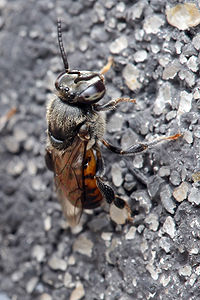
Photo from wikipedia
ETHNOPHARMACOLOGICAL RELEVANCE Plant materials are commonly used in traditional medicine in order to treat various diseases such as Diabetes mellitus. Some plants, such as Syzygium cumini, have the capability to… Click to show full abstract
ETHNOPHARMACOLOGICAL RELEVANCE Plant materials are commonly used in traditional medicine in order to treat various diseases such as Diabetes mellitus. Some plants, such as Syzygium cumini, have the capability to act controlling oxidative stress and protein glycation besides their potential to decrease hyperglycemia and hyperlipidemia by the inhibition of the catalysis of digestive enzymes. The aim of this study was to evaluate the antioxidant and antiglicant activity of S. cumini leaves fractions, their capacity to inhibit hydrolases and lipase enzymes, as well as the cytotoxicity effects against erythrocytes and comparate these results with isolate quercetin flavonoid. MATERIAL AND METHODS Ethnobotanical researches, carried out by academic studies at the Federal University of Uberlandia, led us to choose S. cumini as a potential plant for treatment of Diabetes mellitus. Fractions from ethanolic extract of S. cumini (hexane/Hex, dichloromethane/DCM, ethyl acetate/EtOAc, n-butanol/ButOH and water/H2O) were used to evaluate their antioxidant (DPPH, ORAC and FRAP) and antiglycant (BSA/fructose, BSA/methylglyoxal and Arginine/Methylglyoxal) activity as well as the inhibitory potential against α-amylase, α-glucosidase and lipase. In addition, identification of the main bioactive compounds of S. cuimini leaves by HPLC-ESIMS/MS analysis was carried out. RESULTS Our results indicate that all fractions, for exception Hex, present noteworthy antioxidant activity, mainly in EtOAc and ButOH fractions (FRAP 1154.49±67.37 and 1178.27±21.26 μmol trolox eq g-1, respectively; ORAC 1224.63±58.16 and 1313.53±85.23 μmol trolox eq g-1, respectively; DPPH IC50 15.7±2.4 and 23.5±2.7 μg mL-1, respectively). Regarding the antiglycant activity (BSA/fructose and Arginine/Methylglyoxal models), all fraction, for exception Hex, presented inhibition higher than 85%. All fractions were capable to inhibit 100% of α-amylase and the fractions DCM, EtOAc and ButOH inhibited α-glucosidase more than 50%. Regarding the lipase assay, DCM and Hex had the best activity (31.5±14.3 and 44.3±4.5 μg mL-1, respectively). Various biomolecules known as potent antioxidants were identified in these fractions, such as quercetin, kaempferol, luteolin and (Epi)catechin. CONCLUSION S. cumini fractions and quercetin presented promising antioxidant and antiglycation properties as well as the ability to inhibit digestive enzymes. This study presents new biological activities not yet described for S. cumini which provide new possibilities for further studies in order to assess the antidiabetic potential of S. cumini fractions especially EtOAc and ButOH.
Journal Title: Journal of ethnopharmacology
Year Published: 2020
Link to full text (if available)
Share on Social Media: Sign Up to like & get
recommendations!